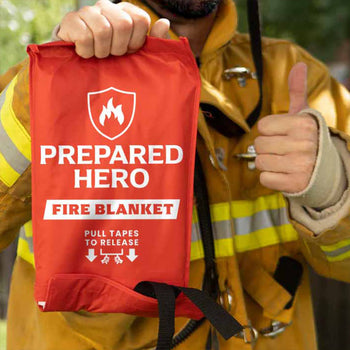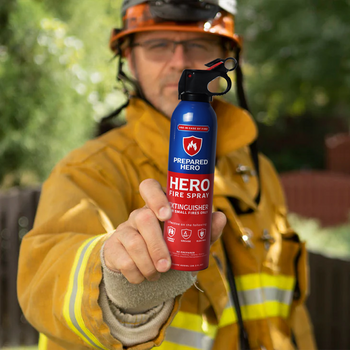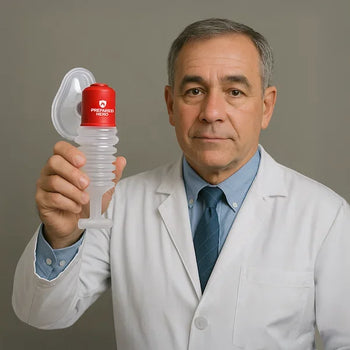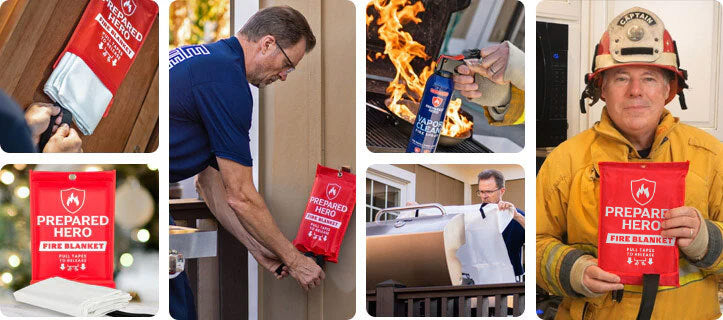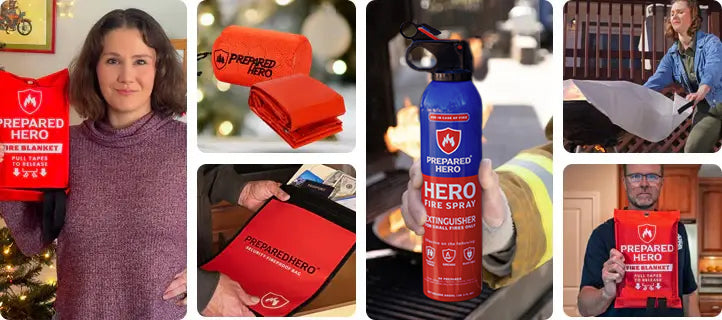Where you put your smoke detectors matters just as much as installing them. Proper placement makes sure they can detect...
Thermal blankets might look simple, but they do much more than you’d think. Whether you’re stuck in the cold, running a marathon, or preparing for an emergency, these lightweight lifesavers help regulate body temperature and protect you against harsh conditions.
But how do they work? Are they effective? What are they used for? This guide breaks down everything you need to know about thermal blankets, from how they trap heat to their many uses.
What Is a Thermal Blanket?

A thermal blanket, also called a space blanket or emergency blanket, helps retain body heat. It’s made from plastic (usually Mylar) with a reflective aluminum coating. This coating bounces heat back to the body to reduce heat loss and keep you warm in cold conditions.
Originally developed by NASA in 1964, these blankets protected astronauts and spacecraft from extreme temperatures. Since then, they’ve become a must-have for emergency kits, outdoor survival, and even hospitals.
Thermal blankets are compact and easy to carry, so they’re popular with hikers, campers, and rescue teams. They can trap up to 90% of body heat, which helps prevent hypothermia. Athletes also use them after endurance races to regulate their body temperature.
These blankets have other uses beyond retaining heat. Their reflective surface can signal rescuers if you're lost, and they can provide shade in hot weather. Some people even use them as makeshift shelters in extreme conditions.
They’re also common in hospitals, where they help patients maintain body temperature when needed. Whether you’re outdoors, in an emergency, or recovering from medical treatment, a thermal blanket is a simple but effective tool to help regulate body heat.
How Do Thermal Blankets Work?
Your body naturally loses heat in a few ways: radiation, conduction, convection, and evaporation. Thermal blankets mainly involve radiation and convection. Here’s how thermal blankets work:
- Reflecting Body Heat
Your body constantly gives off heat as infrared radiation. The shiny aluminum coating reflects this heat toward you and prevents it from escaping. These help you stay warm without an external heat source.
- Blocking Wind and Moisture
Thermal blankets can also act as windproof and waterproof barriers. Wrapping one around yourself stops the breeze from pulling heat away from your skin (aka convection) if you're in cold, windy conditions. It also prevents sweat from evaporating too quickly, which helps keep you warm.
Thermal blankets reflect heat but don’t provide insulation. This means they don’t stop heat loss through conduction (like lying on cold ground). You'd need extra layers underneath if you want to use them for insulation.
In addition, you’ll see thermal blankets in car emergency kits, go bags, marathons, search-and-rescue operations, hospitals, and even veterinary clinics. For example, animals under anesthesia lose heat quickly, so thermal blankets help keep their temperature stable.
What Does a Thermal Blanket Do?

A thermal blanket might not look like much, but it can be a lifesaver in an emergency. Whether you're stuck in the cold, caught in the rain, or need a quick shelter, this lightweight and compact tool has your back. Here’s what a thermal blanket does:
1. Reflects Your Body Heat
The main job of a thermal blanket is to keep you warm by reflecting your body heat. They have a shiny, metallic inside that bounces heat inward instead of letting it escape. This helps prevent rapid body heat loss, which is useful in emergencies. A thermal blanket can slow down heat loss and prevent hypothermia if you're stranded in cold weather. Since they don’t generate heat, they work best when wrapped snugly around you.
2. Blocks Wind and Moisture
Thermal blankets do more than just reflect heat. They also block wind and moisture. Their waterproof design keeps rain and snow from soaking you. Plus, they’re windproof, which helps reduce the chilling effect of cold air. In short, wrapping yourself in a thermal blanket can help you stay warmer and drier while waiting for rescue.
3. Compact and Lightweight
Thermal blankets fold into a compact size, often small enough to fit in your pocket. Despite their lightweight design, they are durable enough for emergencies. This makes them a must-have in first aid kits, camping gear, and survival packs. Because they take up almost no space, you can carry one easily without adding much weight to your gear.
4. For Survival
Thermal blankets aren’t just for warmth. Their reflective surface can signal to rescuers. For instance, Prepared Hero’s Survival Bag has a bright orange exterior that rescuers can spot from afar.
You can also use them as makeshift ground covers, emergency rain shelters, or sleeping bag lining for extra insulation. Some people even use them to make DIY solar stoves. The same technology is used for the Hero Poncho, which is a poncho version of a thermal blanket.
Benefits of Thermal Blankets

Whether you need warmth, protection from the elements, or a backup survival tool, thermal blankets are a smart and practical choice. Here are the top benefits of thermal blankets:
1. Keep You Warm Efficiently
Thermal blankets prevent body heat loss by reflecting warmth to you. Unlike regular blankets, which rely on thick layers to insulate heat, these blankets use a special heat-reflective material to trap warmth. This makes them incredibly effective, especially in cold environments where maintaining body temperature is crucial. A thermal blanket helps keep you warm whether you're wrapped in one during an emergency or using it at home.
2. Lightweight and Comfortable
One of the best things about thermal blankets is their lightweight design. They provide the same warmth as multiple layers of regular blankets without weighing you down. This makes them ideal for people who need warmth, including campers, hospital patients, and those stranded during a blizzard. They’re also easy to carry, which is why they are common in emergency and wilderness survival kits. Simply fold one up and toss it in a backpack.
3. Easy to Clean and Store
Unlike traditional blankets that need to be frequently washed, thermal blankets are low-maintenance. They’re easy to wipe, clean, and dry. Their compact design also makes them simple to store.
Plus, they don’t absorb moisture easily, so they work in damp or humid conditions. This makes them a great choice for people who need a reliable, hassle-free way to stay warm.
4. Weatherproof and Durable
Thermal blankets can also withstand tough conditions. Their windproof and waterproof materials help protect against rain, snow, and cold gusts of wind. These make them perfect for outdoor activities like camping, hiking, and emergency survival.
Unlike traditional blankets that can get soaked and cold, thermal blankets remain functional even in wet conditions. Plus, they’re tear-resistant, so they won’t easily rip apart when exposed to rough handling.
5. Essential for Emergencies
Thermal blankets help prevent hypothermia by retaining up to 90% of body heat. Their reflective surface also makes them highly visible, which is useful for signaling rescuers if you're lost.
Plus, they can serve as emergency shelters or ground covers and collect rainwater. A thermal blanket helps keep you safe whether you're stranded in the cold or lost in the middle of the wild.
Are Thermal Blankets Effective?

Thermal blankets are effective. They work by reflecting your body heat back to you, helping prevent heat loss. They’re also lightweight, compact, and easy to stash in a backpack or car. However, they have limits. They don’t generate heat. These blankets only trap what your body produces.
So, stay as dry as possible before wrapping yourself in one. Layering your blanket with dry insulation, like clothing or a sleeping bag, helps maximize your body heat.
They also have other uses. You can use them as rain barriers, ground covers, or to signal for help. While they aren’t a perfect solution for staying warm overnight, they can save your life. Just use them wisely.
Why Do People Use Thermal Blankets?

Thermal blankets are used in emergencies, outdoor activities, and sports competitions. Let’s take a look at why people use thermal blankets below:
1. Emergency and Survival
People use space blankets for emergencies. They trap body heat and are waterproof and windproof. Campers, hikers, and first responders keep them in survival kits because they’re small, easy to pack, and provide warmth when needed.
2. Sports Competitions
You’ve probably seen marathon runners wrapped in shiny blankets after finishing a race. It’s because their body temperatures can drop quickly after intense running. Thermal blankets help regulate heat loss so runners stay warm while their bodies adjust.
3. Camping and Outdoor Adventures
Hikers and backpackers carry space blankets as a lightweight alternative to bulky blankets. They can be used as emergency shelters, ground covers, or rain collectors.
4. First Aid and Surgery
Paramedics and emergency responders use thermal blankets to help treat shock and hypothermia. The reflective material helps maintain the person’s body temperature until help arrives. Hospitals also use them to keep patients warm after surgery.
5. Disaster Relief and Aid
Disaster responders also distribute thermal blankets to people who have lost shelter. They provide warmth and protect people from wind and rain. These give those in crisis a bit of comfort.
6. Military
Military forces use a more durable version of the space blanket. It’s called a casualty blanket and provides extra insulation.
Some reports suggest space blankets have also been used to block thermal imaging. Thermal cameras pick up heat signatures from people and equipment, even in total darkness. As a result, soldiers or machines become easy targets.
How Long Do Thermal Blankets Last?

Thermal blankets can last quite a while if you handle them carefully. They’re reusable but not indestructible. The reflective coating can wear off with rough use. Tears and holes can also make them less effective at trapping heat. Just make sure to take care of them, and they should last. Check out how to properly store the Hero Survival Bag (our thermal blanket) here.
What Is the Purpose of Thermal Blankets?
The main purpose of thermal blankets is to keep you warm. They do this by trapping your body heat. The shiny aluminum coating reflects heat inward so it doesn’t escape. This makes them useful in cold conditions where heat loss can lead to hypothermia.
In particular, thermal blankets are made from a thin polyethylene layer that acts as a barrier against wind and moisture. This helps protect you against the elements, keeps you dry, and reduces heat loss. They’re also lightweight and compact, so they’re easy to carry in a first aid kit, bug out bag, or backpack.
Thermal blankets are also widely used by outdoor enthusiasts, emergency responders, and medical professionals. They’re crucial for campers, patients, and athletes who need quick warmth after intense activity or surgery. Meanwhile, rescue teams use them to stabilize people suffering from shock or extreme temperature exposure.
The reflective surface can also signal rescuers in emergencies. Plus, they can serve as makeshift shelters, ground covers, or line sleeping bags.
What Is the Warmest Blanket?

The warmest blankets are made from wool, down, fleece, sherpa, Mylar, or electric heating elements. Wool blankets, especially Merino or alpaca wool, are perfect for cold climates. Down comforters, filled with goose or duck down, also trap heat efficiently without being too heavy. If you prefer something soft and cozy, fleece and sherpa blankets offer plush warmth and are great for lounging. On the other hand, electric blankets provide adjustable heat settings. Thermal blankets are also useful when you’re stranded in the middle of nowhere.
Do Thermal Blankets Keep Heat Out?
Yes, thermal blankets can help keep heat out. They work by reflecting heat away instead of letting it pass through. That’s why emergency blankets, which are usually made of Mylar, can serve as emergency shelters in hot weather. Some even use them on cars or tents to reduce heat buildup. They’re lightweight, easy to use, and effective. Just make sure the reflective side faces outward to bounce the heat away.
Conclusion
Thermal blankets reflect body heat, block wind & moisture, and pack down small for easy storage. While they don’t generate heat, they retain what your body produces. They’ve got your back whether you’re camping, running a marathon, or stuck in the cold.
Do you want reliable, easy-to-use, and affordable survival tools for your adventures? Check out Prepared Hero’s survival tools here, and get up to 51% off on certain items. Stay prepared, hero!


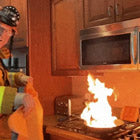 Fire
Fire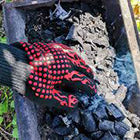 Safety
Safety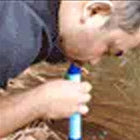 Survival
Survival Protection
Protection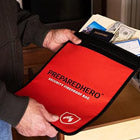 New
New
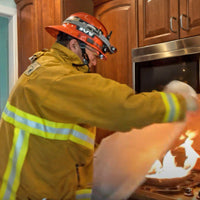 Fire
Fire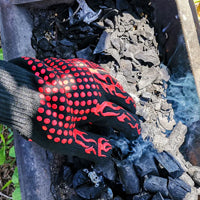 Safety
Safety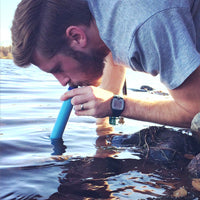 Survival
Survival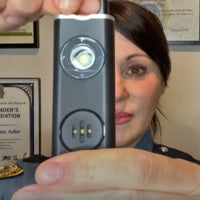 Protection
Protection New
New
